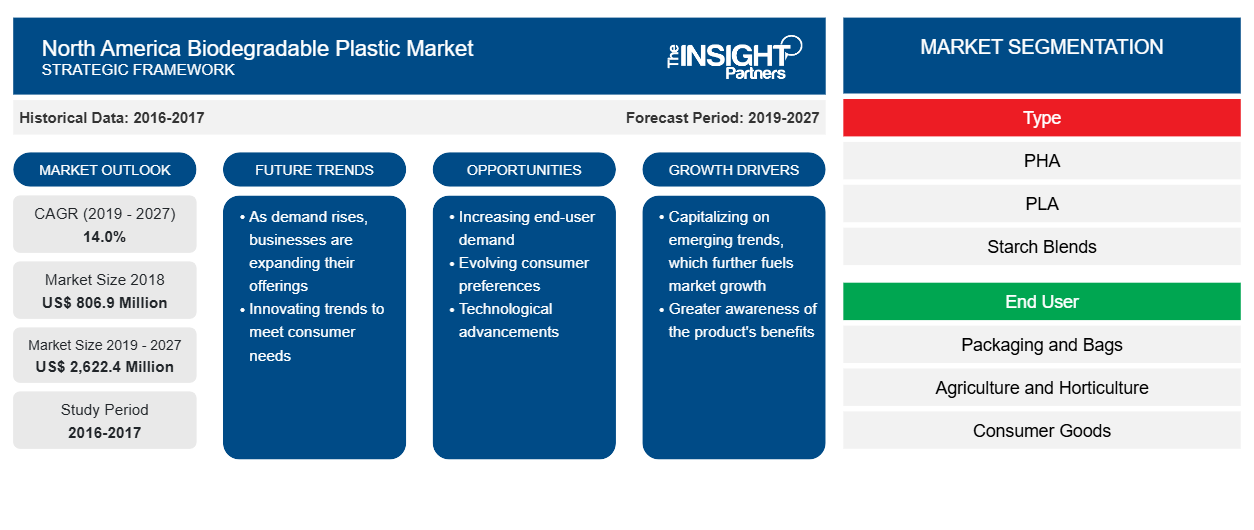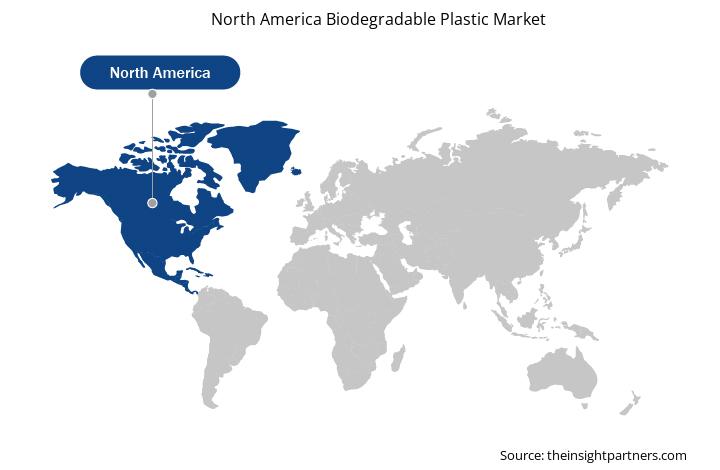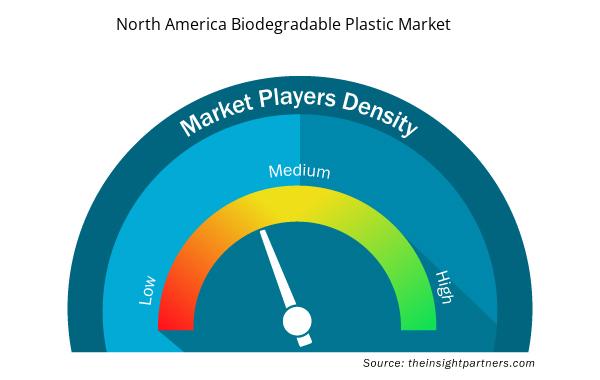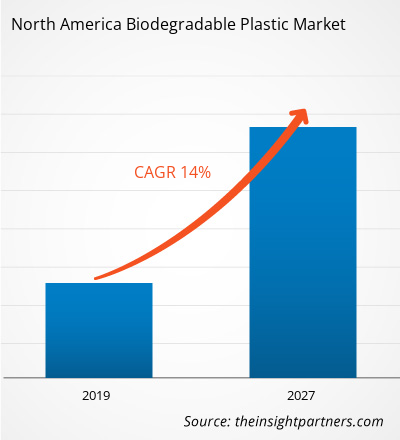The North America biodegradable plastic market is accounted to US$ 806.9 Mn in 2018 and is expected to grow at a CAGR of 14.0% during the forecast period 2019 – 2027, to account to US$ 2,622.4 Mn by 2027.
U.S. is dominating the North America biodegradable plastic market followed by Canada. The market for biodegradable plastic is growing in U.S. due to increasing concerns by the consumers over the impact plastic products have on the environment. The manufacturers have come up with several innovations in the case of plastics to turn it up into greener products. The development of bioresin as an environmentally friendly substitute to polyurethane-based plastic is considered to be one of the important transformations towards the green future. New York City has also supported the bans on no-biodegradable plastics by imposing strict guidelines for recycling plastic bags. Also, cities like Boston and Phoenix, have started charging fees or banning bags below a certain level of thickness. Apart from this, the other cities which have banned the use of plastic bags in U.S. are Chicago Seattle, Los Angeles, Austin and San Francisco, Washington, Brownsville, and Portland.
North America Biodegradable Plastic Market

- This FREE sample will include data analysis, ranging from market trends to estimates and forecasts.
- This FREE sample will include data analysis, ranging from market trends to estimates and forecasts.
Market Insights
Growing awareness of the adverse effects attributed to conventional plastics
The customers in developed and developing countries have been notified of the ill effects of conventional plastics on their lifestyle and the environment. As a result, they demand more environmentally friendly products, which leads to a depreciation in the use of crude oil and natural gas, that results in the reduction carbon footprints. The biodegradable plastics are amalgamated using renewable resources as well as fossil raw materials, such as cellulose ester, PLA, PHA, starch derivatives, and copolyesters (PBS, PBAT, etc.). Various organizations are engaged in bringing transformation in the handling of plastics, through strategic planning, communication, consumer awareness campaigns, documentary films, education, clean up campaigns, raising business awareness, scientific research, entrepreneurial innovation, legislation, and sustainability.
Type Insights
Based on type, the North America biodegradable plastic market is bifurcated as PHA, PLA, starch blends, biodegradable polyesters and others. The starch blend segment dominated the North America biodegradable plastic market. The starch blend polymer bio-blends are biodegradable polymeric materials which are composed of cellulosic-based biomaterials that can be degraded by enzymes and microorganisms. The mixture of starch and polyolefin produces a single material carrying the biodegradation properties of starch with the thermal, mechanical and barrier properties of polyolefin. The common starches that are used are rice starch, sago and tapioca starch, whereas the polyolefin used are polypropylene and polyethylene. Starch is a naturally occurring polymer that is found in plants such as corn, rice and potatoes in the form of water-insoluble granules and has been receiving growing attention as raw material for the production of films due to the lack of the availability of the conventional film-forming resins.
End User Insights
The North America Biodegradable plastic market is bifurcated based on end user into packaging and bags, agriculture and horticulture, consumer goods, textile and others. The packaging and bags segment accounted for the largest share in the North America biodegradable plastic market. The adoption of PLA, being a potentially recyclable material, is gaining an upsurge for the biodegradable plastic rigid packaging market. Flexible packaging solutions including, trays and films that are most suitable for the packaging of fresh fruits and vegetables as they allow a more extended shelf life. In the present scenario, packaging processes and materials are highly sophisticated and flexible to meet application and preservations requirements. The biodegradable plastic industry is continuously working on enhancing barrier properties such as antimicrobial coating to attain improved preservation of food products.
North America Biodegradable Plastic Market by Type

- This FREE sample will include data analysis, ranging from market trends to estimates and forecasts.
- This FREE sample will include data analysis, ranging from market trends to estimates and forecasts.
Customize This Report To Suit Your Requirement
You will get customization on any report - free of charge - including parts of this report, or country-level analysis, Excel Data pack, as well as avail great offers and discounts for start-ups & universities
North America Biodegradable Plastic Market: Strategic Insights

- Get Top Key Market Trends of this report.This FREE sample will include data analysis, ranging from market trends to estimates and forecasts.
You will get customization on any report - free of charge - including parts of this report, or country-level analysis, Excel Data pack, as well as avail great offers and discounts for start-ups & universities
North America Biodegradable Plastic Market: Strategic Insights

- Get Top Key Market Trends of this report.This FREE sample will include data analysis, ranging from market trends to estimates and forecasts.
New product development, market initiatives and merger and acquisition were observed as the most adopted strategies in North America biodegradable plastic market. Few of the recent developments in the North America Biodegradable plastic market are listed below:
2018:
Sealed Air Corporation would start offering their packaged food items in the U.S., Mexico and Canada. These packaging materials are made up of bio based materials of Plantic Technologies Limited.
2019:
NatureWorks and its partners will showcase new, innovative Ingeo PLA biomaterials that demonstrate how Ingeo can be tailored to enhance performance attributes critical to the 3D market like heat and impact resistance or clean incineration for foundry applications.
2017:
Green Dot Bioplastics developed its new biodegradable plastic, Terratek BD2114. It is basically created for the making of plantable pots. NORTH AMERICA BIODEGRADABLE PLASTIC MARKET SEGMENTATION
By Type
- PHA
- PLA
- Starch Blends
- Biodegradable Polyesters
- Others
By End User
- Packaging and Bags
- Agriculture and Horticulture
- Consumer Goods
- Textile
- Others
By Country
- U.S.
- Canada
- Mexico
Company Profiles
- API SpA
- BASF S.E.
- FKuR Kunststoff GmbH
- Green Dot Bioplastics
- NatureWorks LLC.
- Novamont S.p.A.
- Kingfa Sci. & Tech. Co., Ltd.
- Mitsubishi Chemical Corporation
- Plantic Technologies Limited
- Total Corbion PLA
North America Biodegradable Plastic Market Regional Insights
The regional trends and factors influencing the North America Biodegradable Plastic Market throughout the forecast period have been thoroughly explained by the analysts at Insight Partners. This section also discusses North America Biodegradable Plastic Market segments and geography across North America, Europe, Asia Pacific, Middle East and Africa, and South and Central America.

- Get the Regional Specific Data for North America Biodegradable Plastic Market
North America Biodegradable Plastic Market Report Scope
| Report Attribute | Details |
|---|---|
| Market size in 2018 | US$ 806.9 Million |
| Market Size by 2027 | US$ 2,622.4 Million |
| Global CAGR (2019 - 2027) | 14.0% |
| Historical Data | 2016-2017 |
| Forecast period | 2019-2027 |
| Segments Covered |
By Type
|
| Regions and Countries Covered | North America
|
| Market leaders and key company profiles |
North America Biodegradable Plastic Market Players Density: Understanding Its Impact on Business Dynamics
The North America Biodegradable Plastic Market is growing rapidly, driven by increasing end-user demand due to factors such as evolving consumer preferences, technological advancements, and greater awareness of the product's benefits. As demand rises, businesses are expanding their offerings, innovating to meet consumer needs, and capitalizing on emerging trends, which further fuels market growth.
Market players density refers to the distribution of firms or companies operating within a particular market or industry. It indicates how many competitors (market players) are present in a given market space relative to its size or total market value.
Major Companies operating in the North America Biodegradable Plastic Market are:
- API SpA
- BASF S.E.
- FKuR Kunststoff GmbH
- Green Dot Bioplastics
- NatureWorks LLC.
Disclaimer: The companies listed above are not ranked in any particular order.

- Get the North America Biodegradable Plastic Market top key players overview
- Historical Analysis (2 Years), Base Year, Forecast (7 Years) with CAGR
- PEST and SWOT Analysis
- Market Size Value / Volume - Global, Regional, Country
- Industry and Competitive Landscape
- Excel Dataset



Report Coverage
Revenue forecast, Company Analysis, Industry landscape, Growth factors, and Trends

Segment Covered
Type, End User, and Country

Regional Scope
North America, Europe, Asia Pacific, Middle East & Africa, South & Central America

Country Scope
US, Canada
Trends and growth analysis reports related to Chemicals and Materials : READ MORE..
- API SpA
- BASF S.E.
- FKuR Kunststoff GmbH
- Green Dot Bioplastics
- NatureWorks LLC.
- Novamont S.p.A.
- Kingfa Sci. & Tech. Co., Ltd.
- Mitsubishi Chemical Corporation
- Plantic Technologies Limited
- Total Corbion PLA

 Get Free Sample For
Get Free Sample For